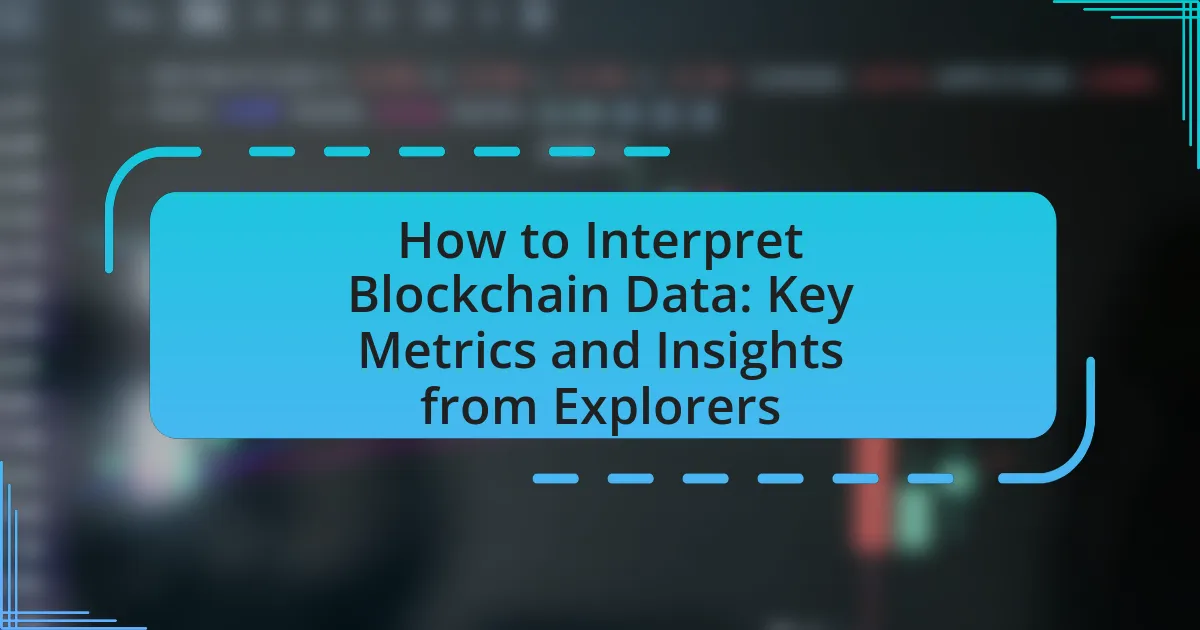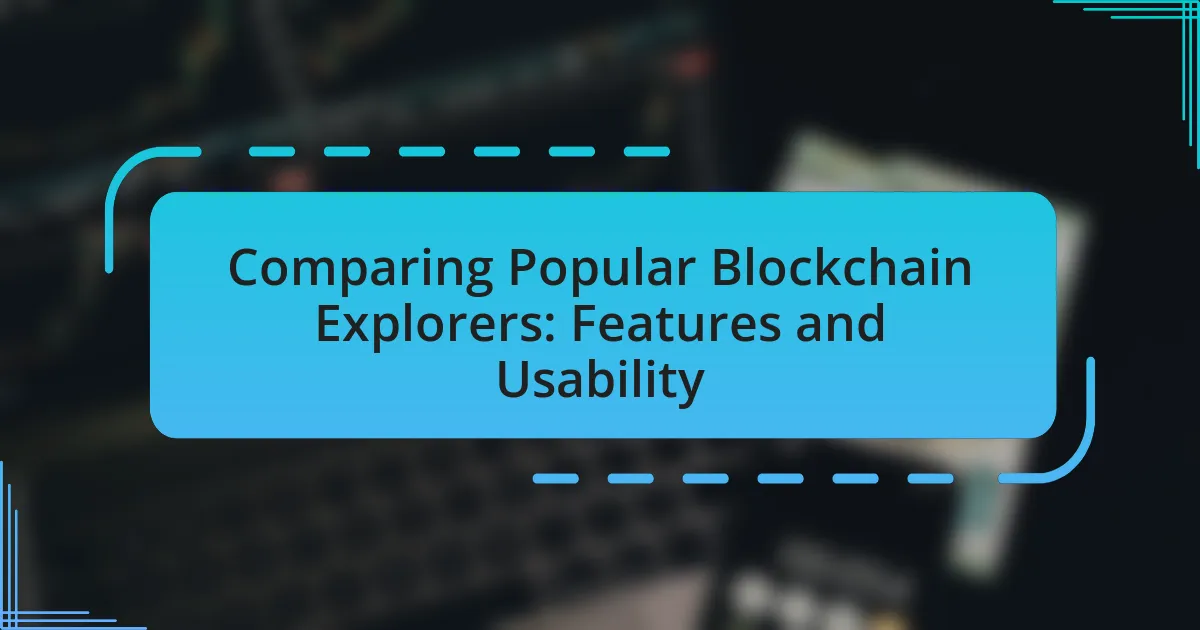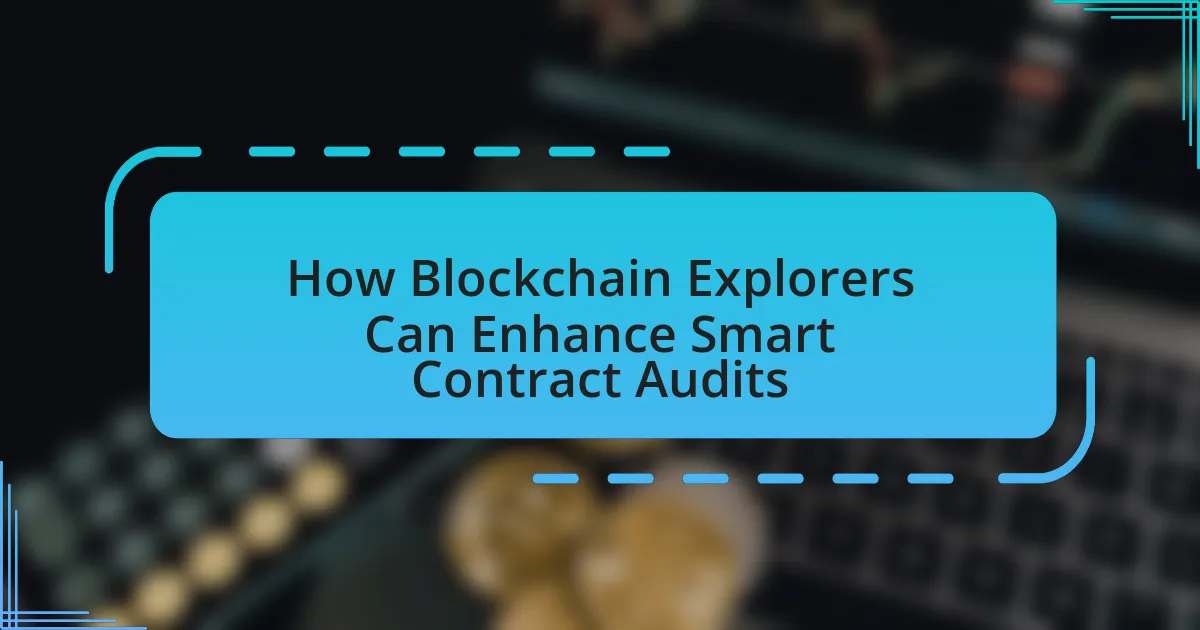Blockchain explorers are essential online tools that provide users with the ability to view and analyze blockchain data, enhancing transparency and accountability within cryptocurrency ecosystems. This article explores the evolution of blockchain explorers, detailing their initial focus on Bitcoin and the subsequent expansion to support multiple blockchains, including Ethereum and others. Key features of blockchain explorers, such as real-time transaction tracking, user-friendly interfaces, and advanced data analytics, are discussed, along with the technological advancements that have facilitated multi-chain support. Additionally, the article addresses the importance of user interaction, security measures, and best practices for utilizing these tools effectively.
What are Blockchain Explorers and Their Purpose?
Blockchain explorers are online tools that allow users to view and analyze blockchain data. Their primary purpose is to provide transparency by enabling users to track transactions, view block details, and monitor wallet addresses on a blockchain network. For instance, Bitcoin blockchain explorers like Blockchair and Blockchain.com display transaction histories, block confirmations, and network statistics, facilitating user engagement and trust in the system.
How do Blockchain Explorers function in the cryptocurrency ecosystem?
Blockchain explorers function as tools that allow users to view and interact with the data stored on a blockchain. They provide a user-friendly interface to access transaction histories, block details, and wallet addresses, enabling users to track the status of transactions in real-time. For instance, Bitcoin blockchain explorers like Blockchair and Blockchain.com display information such as transaction IDs, timestamps, and the amount of cryptocurrency transferred, which enhances transparency and accountability in the cryptocurrency ecosystem. This functionality is crucial for users to verify transactions and ensure the integrity of the blockchain, as it allows them to independently confirm that transactions have been processed and recorded correctly.
What key features define a Blockchain Explorer?
A Blockchain Explorer is defined by its ability to provide real-time access to blockchain data, including transaction history, block details, and wallet information. Key features include a user-friendly interface that allows users to search for specific transactions or addresses, detailed information on each block such as timestamps and miner data, and the ability to view transaction confirmations and statuses. Additionally, many explorers support multiple cryptocurrencies, enabling users to track various blockchain networks in one platform. These features collectively enhance transparency and usability, making blockchain data accessible to both technical and non-technical users.
How do users interact with Blockchain Explorers?
Users interact with Blockchain Explorers primarily by searching for transaction details, wallet addresses, and block information. They utilize the search functionality to input specific transaction IDs or addresses, allowing them to retrieve real-time data about transactions, including confirmation status, fees, and timestamps. Additionally, users can navigate through blocks to view historical data and analyze network activity, which is essential for transparency and verification in blockchain ecosystems. This interaction is supported by the user-friendly interfaces of explorers, which often display comprehensive metrics and visualizations, enhancing the overall user experience.
Why are Blockchain Explorers essential for cryptocurrency users?
Blockchain explorers are essential for cryptocurrency users because they provide a transparent and accessible way to view transaction data on the blockchain. These tools allow users to track their transactions, verify the status of transfers, and ensure the integrity of the blockchain by displaying all recorded activities in real-time. For instance, Bitcoin’s blockchain explorer enables users to see transaction details such as timestamps, amounts, and addresses involved, which enhances trust and accountability in the cryptocurrency ecosystem.
What information can users obtain from Blockchain Explorers?
Users can obtain transaction details, block information, and wallet addresses from Blockchain Explorers. Specifically, they can view transaction hashes, timestamps, amounts, and the status of transactions, as well as details about the blocks such as block height, miner information, and the number of transactions per block. Additionally, users can track wallet balances and transaction histories associated with specific addresses, providing transparency and traceability within the blockchain network. This information is crucial for verifying transactions and understanding the flow of assets on the blockchain.
How do Blockchain Explorers enhance transparency in transactions?
Blockchain explorers enhance transparency in transactions by providing real-time access to transaction data recorded on the blockchain. These tools allow users to view transaction histories, including details such as sender and receiver addresses, transaction amounts, and timestamps. For instance, Bitcoin blockchain explorers like Blockchair and Blockchain.com enable users to track every transaction made on the Bitcoin network, ensuring that all activities are publicly verifiable. This transparency is crucial as it fosters trust among users, as anyone can independently verify the legitimacy of transactions without relying on intermediaries.
How did Blockchain Explorers evolve from Bitcoin to Multi-Chain Support?
Blockchain explorers evolved from Bitcoin to multi-chain support by initially focusing on Bitcoin’s blockchain data, enabling users to view transaction histories and wallet balances. As the cryptocurrency ecosystem expanded, explorers adapted to support additional blockchains, integrating features that allowed users to track transactions across various networks like Ethereum, Binance Smart Chain, and others. This evolution was driven by the increasing demand for transparency and accessibility in the growing decentralized finance (DeFi) space, leading to the development of multi-chain explorers that aggregate data from multiple blockchains, thereby enhancing user experience and functionality.
What were the initial features of early Bitcoin Explorers?
Early Bitcoin explorers primarily featured transaction tracking, block information display, and wallet address lookup. These explorers allowed users to view transaction details such as amounts, timestamps, and confirmations, which were essential for verifying the status of Bitcoin transactions. Additionally, they provided information about blocks, including block height, miner details, and the total number of transactions within each block. The ability to search for specific wallet addresses enabled users to monitor their own transactions and balances, contributing to transparency in the Bitcoin network.
How did the introduction of Ethereum change the landscape of Blockchain Explorers?
The introduction of Ethereum significantly transformed the landscape of Blockchain Explorers by enabling the exploration of smart contracts and decentralized applications (dApps) alongside traditional transaction data. Prior to Ethereum, Blockchain Explorers primarily focused on Bitcoin transactions, which limited their functionality to simple value transfers. With Ethereum’s launch in 2015, explorers began to incorporate features that allowed users to view and interact with complex smart contracts, token transactions, and decentralized finance (DeFi) protocols. This shift expanded the utility of Blockchain Explorers, as they now provide insights into various tokens, contract interactions, and the overall activity within the Ethereum ecosystem, reflecting the growing complexity and diversity of blockchain technology.
What challenges did early Blockchain Explorers face?
Early Blockchain Explorers faced significant challenges including limited user interfaces, lack of comprehensive data, and scalability issues. The initial explorers had to navigate complex command-line interfaces, which made it difficult for non-technical users to access blockchain data. Additionally, early blockchains like Bitcoin had limited transaction data available, making it challenging to analyze trends or perform in-depth research. Scalability issues arose as transaction volumes increased, leading to slower processing times and higher fees, which further complicated the user experience. These challenges hindered widespread adoption and usability of blockchain technology in its early stages.
How have Blockchain Explorers adapted to support multiple blockchains?
Blockchain explorers have adapted to support multiple blockchains by integrating functionalities that allow users to interact with various blockchain networks from a single interface. This adaptation includes the development of universal APIs that facilitate data retrieval across different blockchains, enabling features such as transaction tracking, block verification, and wallet monitoring for multiple cryptocurrencies. Additionally, many explorers have implemented modular architectures that allow for the easy addition of new blockchain protocols, ensuring they remain relevant as the blockchain ecosystem evolves. For instance, platforms like Blockchair and Etherscan have expanded their services to include support for Ethereum, Bitcoin Cash, and other altcoins, demonstrating their capability to handle diverse blockchain data efficiently.
What technological advancements facilitated multi-chain support?
Technological advancements that facilitated multi-chain support include interoperability protocols, cross-chain bridges, and decentralized exchanges. Interoperability protocols, such as Polkadot and Cosmos, enable different blockchains to communicate and share data seamlessly, allowing for a cohesive multi-chain ecosystem. Cross-chain bridges, like Wrapped Bitcoin and RenVM, allow assets to move between chains, enhancing liquidity and usability across platforms. Decentralized exchanges, such as Uniswap and SushiSwap, support trading across multiple blockchains, further promoting multi-chain interactions. These advancements collectively enhance the functionality and user experience of blockchain networks, making multi-chain support a viable and efficient option.
How do multi-chain explorers differ from single-chain explorers?
Multi-chain explorers differ from single-chain explorers primarily in their ability to track and display data across multiple blockchain networks simultaneously. Single-chain explorers are designed to provide detailed information and analytics for a specific blockchain, such as Bitcoin or Ethereum, focusing solely on transactions, blocks, and addresses within that single network. In contrast, multi-chain explorers aggregate and present data from various blockchains, allowing users to view transactions, token movements, and other relevant information across different ecosystems in one interface. This capability is increasingly important as the blockchain landscape evolves, with numerous projects and tokens existing on multiple chains, necessitating a comprehensive view for users and developers.
What are the current trends in Blockchain Explorer development?
Current trends in Blockchain Explorer development include enhanced multi-chain support, improved user interfaces, and advanced data analytics capabilities. Multi-chain support allows users to explore various blockchain networks seamlessly, reflecting the growing diversity of blockchain ecosystems. Improved user interfaces focus on providing intuitive navigation and visualization tools, making it easier for users to access and interpret blockchain data. Advanced data analytics capabilities enable deeper insights into transaction patterns and network activity, catering to the increasing demand for comprehensive blockchain analysis. These trends are driven by the need for greater accessibility and functionality in the rapidly evolving blockchain landscape.
How are user interfaces evolving in Blockchain Explorers?
User interfaces in blockchain explorers are evolving to enhance user experience and accessibility. This evolution includes the integration of more intuitive designs, real-time data visualization, and multi-chain support, allowing users to navigate complex blockchain data more easily. For instance, modern explorers now feature simplified dashboards that present transaction histories, wallet balances, and network statistics in a user-friendly manner, catering to both novice and experienced users. Additionally, the shift towards multi-chain explorers reflects the growing need for interoperability, enabling users to access and analyze data across various blockchain networks seamlessly. This trend is supported by the increasing demand for comprehensive blockchain analytics tools, as evidenced by the rise of platforms like Etherscan and Polygonscan, which provide detailed insights into multiple blockchain ecosystems.
What role does data visualization play in modern Blockchain Explorers?
Data visualization plays a crucial role in modern Blockchain Explorers by transforming complex blockchain data into accessible and understandable formats. This enables users to easily interpret transaction histories, network statistics, and other relevant metrics. For instance, visual representations such as graphs and charts allow users to quickly identify trends, anomalies, and patterns within blockchain activity, enhancing their ability to make informed decisions. Furthermore, effective data visualization can improve user engagement and facilitate better navigation through vast amounts of blockchain data, ultimately contributing to a more user-friendly experience in exploring multi-chain environments.
How are mobile applications impacting the use of Blockchain Explorers?
Mobile applications are significantly enhancing the accessibility and usability of Blockchain Explorers. By providing user-friendly interfaces and real-time data access, these applications allow users to easily track transactions, view blockchain data, and interact with various blockchain networks directly from their smartphones. For instance, the rise of mobile wallets integrated with Blockchain Explorers has streamlined the process of monitoring cryptocurrency transactions, making it more convenient for users to engage with blockchain technology on-the-go. This shift towards mobile platforms has led to increased user engagement and a broader adoption of blockchain technology, as evidenced by the growing number of downloads and active users of blockchain-related mobile applications.
What security features are being integrated into Blockchain Explorers?
Blockchain explorers are integrating advanced security features such as enhanced encryption protocols, multi-signature authentication, and real-time transaction monitoring. These features aim to protect user data, ensure transaction integrity, and prevent unauthorized access. For instance, multi-signature authentication requires multiple private keys to authorize a transaction, significantly reducing the risk of fraud. Additionally, real-time transaction monitoring helps detect suspicious activities, allowing for immediate action to mitigate potential threats. These integrations reflect the growing emphasis on security in the evolving landscape of blockchain technology.
How do Blockchain Explorers ensure user privacy and data protection?
Blockchain explorers ensure user privacy and data protection primarily through the use of pseudonymous addresses and encryption techniques. Pseudonymous addresses allow users to interact with the blockchain without revealing their real identities, as transactions are linked to these addresses rather than personal information. Additionally, many blockchain explorers implement encryption protocols to secure data transmission and storage, minimizing the risk of unauthorized access. For instance, explorers may utilize HTTPS to encrypt data in transit, ensuring that sensitive information remains confidential. These measures collectively enhance user privacy and protect data integrity within the blockchain ecosystem.
What measures are taken to prevent misinformation in Blockchain Explorers?
Blockchain explorers implement several measures to prevent misinformation, including data verification, user feedback mechanisms, and transparency protocols. Data verification involves cross-referencing blockchain data with multiple nodes to ensure accuracy, while user feedback mechanisms allow users to report discrepancies or errors, fostering community oversight. Transparency protocols, such as open-source code and public access to transaction histories, enable users to independently verify information, thereby reducing the likelihood of misinformation. These combined efforts help maintain the integrity and reliability of the information presented by blockchain explorers.
What best practices should users follow when utilizing Blockchain Explorers?
Users should follow several best practices when utilizing Blockchain Explorers to ensure accurate and efficient navigation of blockchain data. First, users should verify the blockchain network they are exploring, as different networks may have distinct explorers and data formats. For example, Bitcoin transactions can be tracked on Bitcoin-specific explorers, while Ethereum transactions require Ethereum explorers.
Second, users should familiarize themselves with the interface and features of the chosen explorer, such as transaction history, block details, and wallet addresses, to maximize their understanding of the data presented. Third, users should cross-reference information from multiple explorers when possible, as discrepancies can arise due to network delays or data synchronization issues.
Additionally, users should be cautious about sharing sensitive information, such as private keys or personal details, as blockchain explorers are public tools that do not guarantee privacy. Lastly, users should stay updated on the latest developments in blockchain technology and explorer functionalities, as the landscape is continually evolving, impacting how data is accessed and interpreted.
How can users verify transaction authenticity using Blockchain Explorers?
Users can verify transaction authenticity using Blockchain Explorers by entering the transaction ID or wallet address into the search bar of the explorer. This action retrieves detailed information about the transaction, including its status, amount, sender, receiver, and confirmation count. The transparency of blockchain technology ensures that all transactions are publicly recorded and immutable, allowing users to cross-reference the displayed data with their own records for accuracy. For instance, Bitcoin Blockchain Explorers like Blockchair or Blockchain.com provide real-time data that confirms whether a transaction has been successfully processed and included in a block, thus validating its authenticity.
What tips can enhance the user experience with Blockchain Explorers?
To enhance the user experience with Blockchain Explorers, users should prioritize intuitive navigation and comprehensive search functionalities. Intuitive navigation allows users to easily access various features, while comprehensive search functionalities enable quick retrieval of transaction details, addresses, and blocks. Additionally, providing real-time data updates ensures users receive the most current information, which is crucial for tracking transactions effectively. User-friendly interfaces that include visual aids, such as charts and graphs, can further simplify complex data, making it more accessible. Lastly, offering educational resources or tooltips can help users understand blockchain concepts better, thereby improving their overall experience.





